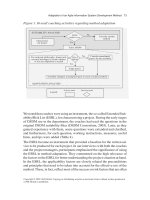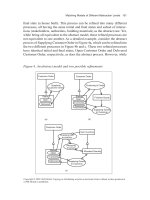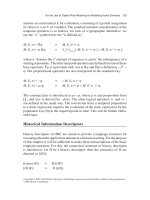Systems Analysis and Design pdf
Bạn đang xem bản rút gọn của tài liệu. Xem và tải ngay bản đầy đủ của tài liệu tại đây (8.89 MB, 518 trang )
Systems Analysis and Design
We work with leading authors to develop the
strongest educational materials in systems analysis,
bringing cutting-edge thinking and best
learning practice to a global market.
Under a range of well-known imprints, including
Financial Times/Prentice Hall, we craft high quality print and
electronic publications which help readers to understand
and apply their content, whether studying or at work.
To find out more about the complete range of our
publishing, please visit us on the World Wide Web at:
www.pearsoned.com
Systems Analysis
and Design
Donald Yeates and Tony Wakefield
Second edition
Pearson Education Limited
Edinburgh Gate
Harlow
Essex CM20 2JE
England
and Associated Companies throughout the world
Visit us on the World Wide Web at:
www.pearsoneduc.com
First published 1994
Second edition published 2004
© Pearson Education Limited 1994, 2004
The rights of Donald Yeates and Tony Wakefield to be identified as
authors of this work have been asserted by them in accordance
with the Copyright, Designs and Patents Act 1988.
All rights reserved. No part of this publication may be reproduced, stored
in a retrieval system, or transmitted in any form or by any means, electronic,
mechanical, photocopying, recording or otherwise, without either the prior
written permission of the publisher or a licence permitting restricted copying
in the united Kingdom issued by the Copyright Licensing Agency Ltd,
90 Tottenham Court Road, London W1T 4LP.
All trademarks used herein are the property of their respective owners.
The use of any trademark in this text does not vest in the author or publisher
any trademark ownership rights in such trademarks, nor does the use of such
trademarks imply any affiliation with or endorsement of this book by such owners.
ISBN 0273 65536 1
British Library Cataloguing-in-Publication Data
A catalogue record for this book is available from the British Library
10 987654321
08 07 06 05 04
Typeset in 10/12
1
/2pt Palatino by 35
Printed and bound by Bell & Bain Limited, Glasgow
The publisher’s policy is to use paper manufactured from sustainable forests.
Contents
Preface xv
Acknowledgements xvii
1 The Context for Analysis and Design 1
1.1 Introduction 1
1.2 Business Analysis 2
1.2.1 Levels of Understanding 2
1.2.2 Linkage of IS to Business Objectives 3
1.3 Constraints 5
1.3.1 The User’s Organisation 5
1.3.2 Working Practices 5
1.3.3 Financial Control Procedures 6
1.3.4 Security and Privacy 6
1.3.5 Legal Considerations 7
1.3.6 Audit Requirements 7
1.3.7 Fallback and Recovery 7
1.4 Using IT for Competitive Advantage 8
1.5 Successful Systems 15
1.6 The Role of the Analyst and Designer 19
1.7 Ethical Considerations 21
1.8 Summary 24
Case Study: System Telecom 24
Case Study: LozCo Ltd 33
2 Approaches to Analysis and Design 34
2.1 Introduction 34
2.2 A Framework for Analysis and Design Methods 34
2.3 SSADM 38
2.4 Object-Orientation 39
2.5 Traditional Approaches 40
2.6 Structured Approaches 42
2.7 SSADM 48
2.8 Yourdon 51
2.9 Jackson 53
2.10 Merise 54
2.11 Rapid Application Development 56
2.11.1 Direct Systems Development Method (DSDM) 56
2.11.2 Principles of DSDM 56
2.12 Workflow Systems 58
2.13 Summary 60
Exercises 61
3 Communicating with People 63
3.1 Introduction 63
3.2 Types of Communication 64
3.3 Barriers to Communication 67
3.4 Improving Your Skills 70
3.4.1 Getting Information 70
3.4.2 Giving Information 72
3.4.3 Meetings 73
3.4.4 Presentations 75
3.5 Summary 82
Exercises 83
4 Building Better Systems 84
4.1 Introduction 84
4.2 Quality Concepts 85
4.3 Quality Gurus 86
4.4 The Cost of Poor Quality 89
4.5 Quality Management 93
4.6 ISO 9000 97
4.6.1 The TickIT Initiative 99
4.7 Quality in the Structured Life Cycle 99
4.7.1 Structured walkthroughs 100
4.7.2 Fagan Inspections 101
4.8 Summary 103
4.8.1 Inputs 105
4.8.2 Outputs 107
4.8.3 Evaluation 107
Exercises 107
5 Project Management 108
5.1 Introduction 108
5.2 Stages of System Development 108
vi Contents
5.2.1 Before Analysis and Design 108
5.2.2 Analysis and Design 110
5.2.3 After Analysis and design 112
5.3 Project Planning 113
5.3.1 Stages in Planning 114
5.3.2 Planning for Quality 119
5.4 Estimating 119
5.4.1 Estimating for Analysis and Design Work 120
5.4.2 Advantages of the Structured Approach 121
5.4.3 Using Function Point Analysis 122
5.5 Project Monitoring and Control 125
5.5.1 The Control of Quality 126
5.5.2 Documentation Control 127
5.5.3 Change Control 127
5.5.4 Configuration Management 128
5.6 PRINCE2 128
5.7 Summary 129
Exercises 129
6 Systems Analysis: Concepts 131
6.1 Introduction 131
6.2 What Is Systems Analysis? 131
6.3 Development Life Cycles 134
6.4 A Structured Approach 140
6.4.1 Structured Systems Analysis 141
6.5 The PARIS Model 142
6.6 Summary 143
7 Systems Analysis: Planning the Approach 144
7.1 Introduction 144
7.2 Objectives and Terms of Reference 146
7.3 Constraints 148
7.4 Preparing for Detailed Analysis 151
7.5 The Feasibility Study 153
7.6 Summary 155
Exercises 156
8 Systems Analysis: Asking Questions and Collecting Data 157
8.1 Introduction 157
8.2 Fact-finding Interviews 158
8.2.1 Planning the Interview 158
8.2.2 Conducting the Interview 164
8.3 Questionnaires 173
8.4 Observation 175
8.5 Record Searching 176
Contents vii
8.6 Document Analysis 176
8.7 Summary 177
Exercises 177
9 Systems Analysis: Recording the Information 180
9.1 Introduction 180
9.2 Data Dictionaries and CASE Tools 181
9.3 Data Flow Diagrams 182
9.3.1 DFD Components 182
9.3.2 DFD Hierarchies 183
9.4 Modelling Current Physical Processing 186
9.5 Entity Models 188
9.5.1 The Logical Data Structuring Technique 188
9.5.2 The Logical Data Model 192
9.6 Modelling Current Data 193
9.7 The Data Catalogue 195
9.8 Recording the Requirements 196
9.9 Summary 196
Exercises 197
Case Study: The Shark Loan Company 197
Case Study: Ravenelli Ice Cream 198
10 Object-Oriented Methods 200
10.1 Introduction 200
10.2 Principles of OO 201
10.2.1 Inheritance 201
10.2.2 Encapsulation 202
10.2.3 Polymorphism 203
10.3 Object-Oriented Models 203
10.3.1 Use Case Diagrams 204
10.3.2 Class Inheritance Diagrams 206
10.3.3 OO Behaviour Models 210
10.4 Summary 215
11 Systems Analysis: Modelling Systems Behaviour 217
11.1 Introduction 217
11.2 Creating a Logical Model of Current Processing 218
11.3 Modelling the Required System 219
11.4 Adding the Time Dimension 220
11.5 Modelling the Effects of System Events 222
11.6 Entity Life Histories 223
11.7 Producing Entity Life Histories 226
11.8 Effect Correspondence Diagrams 228
11.9 Producing Effect Correspondence Diagrams 229
viii Contents
11.10 Modelling Enquiries 230
11.11 Defining the User View of Processing 231
11.12 Modelling Input and Output Data 233
11.13 Modelling OO System Behaviour 234
11.14 Modelling Logic 234
11.15 Size and Frequency Statistics 237
11.16 Summary 239
Exercises 239
12 Systems Analysis: Meeting Business Requirements 242
12.1 Introduction 242
12.2 Agreeing the Options 243
12.2.1 Identifying Options 244
12.2.2 Choosing Between the Options 245
12.2.3 The Use of Prototyping 245
12.2.4 Quantification of Options 246
12.3 Identifying Benefits 249
12.4 Presenting the Requirement 251
12.5 Writing the Functional Specification 252
12.6 Business Analysis 253
12.7 Business Activity Modelling 258
12.8 Business Analysis and IT Strategy 259
12.8.1 IT SWOT 260
12.8.2 Requirements Engineering 262
12.9 Strategic Information Systems 263
12.10 PESTEL Analysis 265
12.11 Summary 267
Exercises 267
13 From Analysis to Design 269
13.1 Introduction 269
13.2 Bridging the Gap 270
13.3 Design Objectives and Constraints 273
13.3.1 Objectives 273
13.3.2 Constraints 274
13.4 Summary 275
14 Systems Design: Information Security 276
14.1 Introduction 276
14.2 Hacking and Viruses 278
14.3 The Purpose of Control 279
14.4 Input Controls 281
14.5 Output Controls 283
14.6 Processing Controls 284
Contents ix
14.7 Storage Controls 286
14.8 Audit Controls 287
14.9 Contingency Planning 287
14.10 Summary 290
Exercises 290
15 Systems Design: Human–Computer Interaction 291
15.1 Introduction 291
15.2 Agreeing the System Boundary 292
15.3 Output Design 292
15.3.1 Output Technology 296
15.3.2 Displaying Information on a Screen 297
15.3.3 The Use of Tables and Graphics 297
15.3.4 Specifying Outputs 299
15.4 Input Design 301
15.4.1 Keyboard Transcription from Clerical Documents 302
15.4.2 Direct Input onto the Computer System Via a
Peripheral Device 304
15.4.3 Direct Entry through Intelligent Terminals 305
15.4.4 Input by Speech 305
15.5 Dialogue design 306
15.5.1 Website Design 307
15.5.2 Dialogue Types 308
15.5.3 WIMP Interfaces 312
15.5.4 User Support 314
15.6 Ergonomics and Interface Design 315
15.7 Summary 317
16 Systems Design: System Interfaces 319
16.1 Introduction 319
16.2 Interfaces Defined 319
16.3 Analysing Interfaces 323
16.4 Physical Forms of Interfaces 326
16.5 Interfaces to Peripherals 331
16.6 Summary 332
17 Systems Design: Logical Data Design 334
17.1 Introduction 334
17.2 The Top-down View: Entity Modelling 335
17.2.1 The Entity Relationship Matrix 336
17.2.2 Summary of Entity Modelling 337
17.3 The Bottom-up View: Third Normal Form Analysis 338
17.4 Merging the Data Models 345
17.5 Testing the Data Model 346
x Contents
17.6 The Data Dictionary 347
17.6.1 Advanced Features of a Data Dictionary 348
17.7 Summary 349
Exercises 350
18 Systems Design: Files 352
18.1 Introduction 352
18.2 Types of Data 352
18.3 Storage Media 354
18.3.1 Magnetic Disk 355
18.4 File Organisation 356
18.4.1 Serial Organisation 357
18.4.2 Sequential Organisation 357
18.4.3 Indexed Sequential Organisation 358
18.4.4 Random Organisation 359
18.4.5 Full Index Organisation 360
18.4.6 Chained Data 360
18.5 Access Methods 362
18.6 Factors Influencing File Design 363
18.7 Summary 365
Exercises 365
19 Systems Design: Databases 366
19.1 Introduction 366
19.2 Database Concepts 367
19.3 Database Models 369
19.4 File Management Systems 370
19.5 Hierarchical Database Systems 372
19.6 Network Database Systems 373
19.7 Relational Database Systems 375
19.7.1 Data Structure 375
19.7.2 Data manipulation 376
19.8 RDBMS Design 380
19.9 Futures 382
19.10 Summary 383
20 Systems Design: Physical Data Design 384
20.1 Introduction 384
20.2 Quantifying the Data Storage Requirements 385
20.3 Assessing the Required System Performance 386
20.3.1 Factors Affecting System Performance 388
20.3.2 Overheads that Adversely Affect System Performance 389
20.4 Investigating the Chosen Hardware/Software Platform 390
20.4.1 Data Storage 391
20.4.2 Data Transfer 392
20.4.3 The Programming Language Used 393
Contents xi
20.5 Moving from Logical to Physical Data Design 393
20.5.1 Creating a Physical Data Design 394
20.5.2 Data Access Diagrams 395
20.5.3 Refining the Physical Data Design 396
20.6 Summary 397
Exercises 397
21 Systems Design: Data Communications 399
21.1 Introduction 399
21.2 Basic Concepts 399
21.3 The Use and Provision of Networks 403
21.4 Carrying Information across Networks 404
21.4.1 Local Area Networks 404
21.4.2 Wide Area Networks 405
21.5 Standards and Standards-making Bodies 406
21.5.1 The OSI Reference Model 406
21.5.2 The Upper Layers 407
21.5.3 The Lower Layers 408
21.5.4 The Transport Layer 409
21.5.5 The X and V Series Recommendations 410
21.5.6 TCP/IP 410
21.6 LANs, WANs and the Internet 411
21.6.1 Client/Server Architecture 412
21.6.2 LANs, WANs and the Internet 412
21.7 Markup languages 413
21.8 Summary 414
Exercises 415
22 Systems Implementation 417
22.1 Introduction 417
22.2 Coding and Unit Test 417
22.2.1 Employing Programmers to Write Code 418
22.2.2 Using Code Generators 419
22.3 Testing: Ensuring the Quality 420
22.4 Data Take-on and Conversion 423
22.5 User Training 425
22.6 Going Live 426
22.7 The Maintenance Cycle 431
22.8 Summary 432
23 Change Management 433
23.1 Introduction 433
23.2 Information Technology and People 434
23.2.1 The Role of Analysts and Designers 436
xii Contents
23.3 Change Management 437
23.3.1 Unfreezing, Moving and Refreezing 438
23.4 The People Project 440
23.4.1 Creating Involvement 440
23.4.2 Building Commitment 442
23.4.3 Providing Skills 443
23.4.4 Managing the Benefits 444
23.5 The Change Management Pay-off 445
23.6 Summary 446
24 What Next? 448
24.1 Introduction 448
24.2 How Did We Get Here? 448
24.3 What’s Happening to Work? 450
24.4 How Shall We Survive? 451
24.4.1 Globalisation 453
24.4.2 Technology and Organisation Design 455
24.5 Business Process Reengineering 457
24.6 Conversations and Conclusions 460
Bibliography and Web References 470
Appendices
1 An Analysis and Design Case Study Using Structured Methods 473
2 ISEB Qualifications 488
Index 491
Contents xiii
H
Preface
This is a substantially new and different edition of Systems Analysis and De-
sign. We hope that the new materials bring it up to date and that we’ve
kept the best of the old. It has been written for people studying systems
analysis and design or who are already working in systems teams. People
who are involved in the development of new systems or the development of
new systems analysts, or both, have written it.
It is intended to be a practical book, easy to read and easy to use. It follows
the same structure as the previous edition and has new and updated
material in it. There are more case studies and exercises too and we’ve cross-
referenced the topics to the ISEB syllabus in systems analysis and design.
There is also a web site for the book for the first time. We’re excited about
the opportunities that this offers. We want to make it interesting and useful
to use. You’ll find more information about Denton Motor Holdings and
some answer pointers to some of the case study problems and exercises.
There are also some end-of-chapter quizzes and the answers to them. You
could use these to check your understanding as you go through the book.
For more information, log on to www.booksites.net/yeates.
We hope that you enjoy the book. It can’t tell you everything you need to
know about analysis and design; no book can do that. There is no substitute
for experience.
Finally our thanks to James Cadle, John Koenigsberger, Steve Copson and
Murdoch Mactaggart for reviewing some of the material for us, and to the
panellists who helped with the final chapter – Debbie Paul, Frank Jones,
Jean-Noel Ezingeard, Nigel Underwood and Richard Bevan. Also, we would
like to thank Amanda Thompson and Tim Parker at Pearson Education for
keeping our noses to the grindstone in the nicest possible way as well as
Lionel Browne and David Hemsley the project editors.
Donald Yeates
Tony Wakefield
February 2003
Disclaimer
The publishers and authors do not accept responsibility in any way for the
failure of analysis and design work carried out based on ideas in this book or
following your reading of the book. Whilst the ideas and good practices are
based on hard won experience, they need to be applied with skill and under-
standing and take account of project circumstances. Good luck!
xvi Preface
Acknowledgements
We are grateful to the following for permission to reproduce copyright material:
Figure 2.7 ‘Custom Order Workflow’, published by Actionworks® – Business
Process Management for People Processes; Fig. 4.2 from The Team Handbook by
Peter Scholtes, published by Oriel Incorporated; Fig. 6.5 from STARTS Guide
1987, supported by the Department of Trade and Industry; Fig. 8.10 ‘NCC clerical
document specification’, published by National Computing Centre.
In some instances we have been unable to trace the owners of copyright material,
and we would appreciate any information that would enable us to do so.
H
1
The Context for Analysis
and Design
1.1 Introduction
Who is this book written for? The whole book is about systems analysis and
design, and it’s been written for people who are analysts or designers already
or people who are thinking about making a career in analysis and design. This
book doesn’t cover all you need to know about the job. No book can ever do
that: there will always be something you’d wish you’d known, and there will
always be something you could have done better. Life will present you with new
problems every day. However, there’s no reason why you should make all of
the same mistakes that other analysts and designers have already made. In this
book many good and experienced analysts, designers, consultants and trainers
offer you their experience in the hope that you will build on it, benefit from it
and be better at your job.
The book is organised in a project-chronological sequence. This means that it
begins with analysis and ends with implementation. There are some chapters,
however, that don’t fit neatly into this sequence, so they have been put in at the
beginning – like this one – or right at the end – like Change Management. They
deal with the environment within which analysis and design takes place and are
concerned with business, people, management and quality. There’s also a basic
assumption running through the book. It is that analysts and designers work for
customers. We believe that the word ‘customer’ is very important. Somebody
pays for what analysts and designers deliver. New systems have to be justified
by the benefits that they deliver. It is easy to use terms such as ‘the users’ and
‘user management’ – they’re used in this book – and forget that they are sub-
stitutes for ‘the customer’. All of the contributors to this book have worked
for companies whose very existence depended on their ability to build and
deliver new computer-based systems and where customer focus came first,
last and everywhere in between. This isn’t to say that only those analysts and
designers who work for service companies have a customer focus. Indeed, the
chapter on Building Better Systems extends the scope of the word ‘customer’
well beyond its everyday usage and beyond the meaning here in this chapter.
We do, however, want you to hold on to the important concept of ‘customer’ as
2 The Context for Analysis and Design
you read this book. There are three other important points that need to be
mentioned here.
• Systems analysis and design involves people. Certainly it involves technology,
often technology that we don’t really understand and which we rely on other
people to manage for us, but the best-designed systems in the world succeed
because the people who use them can do their jobs better. This is because their
information systems enable them to achieve goals they wouldn’t otherwise
reach. There are just too many people on trains and planes using laptop
machines to believe that we can ever in the future manage without computers.
The importance of this ‘people aspect’ is emphasised later where we consider
change management.
• Systems analysts and designers change the world. This is a bold statement,
and in one sense everyone changes the world to some extent just by their very
existence. The role of the systems analyst, however we may describe it in
detail, is to be a change agent. Unless we are interested in changing the way
organisations work we have no need for systems analysts. Unless you are
interested in changing the way organisations work, you probably have no
need to read this book.
• Information systems are expensive to develop and maintain, so it is clear that
businesses do not commission them just for the fun of it. The need for an
information system must grow out of some perceived business requirement,
and the justification for it must be expressed in business terms. Although this
is well enough understood in theory, it is surprising how often IS projects
do start without clear links back to business plans and strategies. System
developers often take the sketchiest of briefs and start to develop something
they think meets the need – and are then unpleasantly surprised when the
user or sponsor of the system refuses to accept it because it does not properly
meet their specific business requirements.
1.2 Business Analysis
1.2.1 Levels of Understanding
A proper analysis of system requirements requires that those carrying out the in-
vestigation have a balance of skills and knowledge. This includes a good general
understanding of the operation of business and of the factors that affect the
viability of all businesses. This involves a broad-based knowledge of finance,
accounting, marketing, production and distribution, ideally gained in a variety of
business environments. There will also be a need for a more specific grasp of the
important features of the particular business being studied. So, for example, an
analyst working for a high street chain of shops should have knowledge of the
retail sector and be able to discuss retailing matters knowledgeably with the
customer. Finally of course a broad knowledge of the possibilities and limitations
of information technology is also required.
This balance of skills is needed for three reasons. First, so that the analysts
understand what the users of the proposed system are saying to them and
can recognise the implications of the requirements they are capturing. Also,
because users will not expect analysts to adopt a completely passive role;
they will want them to challenge assumptions and interject ideas to stimulate
them in thinking out their requirements. Without an understanding of the busi-
ness of the organisation, or of how other organisations have tackled similar
issues, it will not be possible to play this catalytic role. Finally, the users will
generally expect the analysts to devise and propose technical solutions to their
business problems.
Systems analysts, however, are often generalists and, particularly in service
companies, are quite likely to be sent to work with a travel agent on one project,
a bank on the next and a manufacturing company on the third. Although this
can facilitate cross-fertilisation of ideas between different sorts of business, the
disadvantage is, of course, that they sometimes lack the specialist knowledge to
deal with users on an equal basis. So if this is the case, what can be done to bring
relevant experience to bear on a particular assignment?
First, and most obviously, the project manager should try to find analysts with
previous experience of the business to be studied, or something similar. Someone
who has worked on a distribution application, for instance, may have achieved a
reasonable understanding of areas such as stock-keeping and just-in-time deliv-
ery systems, which can be brought into play on a retail assignment. If, however,
analysts with relevant backgrounds are not available, additional support will
have to be provided by arranging some training for the analysts in the areas
of interest in the form of public courses or self-teach packages, or by hiring an
expert to coach them in the new business areas. Alternatively, suitable back-
ground reading can be provided. Another approach is to provide consultancy
support, which can be used either to lead the investigation with the customer
or to provide background advice and guidance for the analysis team.
A particular challenge for analysts, and one that seems more difficult for those
from a technical background such as programming, is to keep the business re-
quirements as the focus instead of getting hooked up on technological solutions.
It is very easy, for example, to take a messy and cumbersome manual system and
produce instead a messy and cumbersome computer system. Analysis should at
all times be tightly focused on the business objectives that the proposed system
is supposed to fulfil, and only when these are thoroughly clear should the
identification of technical solutions be attempted. As we shall see in Chapter 2,
structured methods, particularly SSADM, provide a very good discipline in
this regard, as they tend to conduct requirements analysis and requirements
specification at a wholly logical level and deliberately exclude the consideration
of technical issues until the business requirements have been settled.
1.2.2 Linkage of IS to Business Objectives
There are many reasons why businesses should want to develop information sys-
tems, but some of the most common objectives are:
Business Analysis 3
4 The Context for Analysis and Design
• To reduce manpower costs. The introduction of computer-based systems has
often enabled work to be done by fewer staff or, more likely nowadays, has
permitted new tasks to be undertaken without increasing staffing levels.
The automation of many banking functions, such as cheque clearance, falls
into this category.
• To improve customer service. Computer systems can often allow organisations
to serve customers more quickly or to provide them with additional services.
Supermarket point-of-sale systems producing itemised bills provide an
illustration of this.
• To improve management information. Management decisions can only be as
good as the information on which they are based, so many computer systems
have been designed to produce more, or more accurate, or more timely
information. With modern database query facilities it is even possible to
provide systems that do not require the data retrieval requirements to be
defined in advance, thereby enabling managers to institute new types of
enquiry when changing business conditions demand new or different
information.
• To secure or defend competitive advantage. This is becoming a major justification
for spending on information systems, and is examined in more detail later in
this chapter.
Ideally, the analyst should work from a hierarchy of objectives, each one posing a
challenge to, and imposing constraints upon, those at a lower level. The lower-
level objectives are sometimes referred to as critical success factors: that is, they are
things that must be achieved if the top-level objective is to be met. The critical
success factors will become more detailed and tightly focused as one works
down the hierarchy, and perhaps this may be best illustrated by an example.
Let us consider a motor-car manufacturing company. It currently has, say,
10% of the market for its products, and the board has defined a five-year mission
of raising that proportion to 20%. But this is a very broad target and, to achieve
it, the organisation will have to define a set of more tangible objectives that
will lead to its being met – in other words, the critical success factors. It may be
felt that one key to increasing market share is to offer a more frequent choice of
new models. So, a lower-level objective for the design team may be to reduce the
time to develop a new model from, say, five years to two. And the production
department will have to be able to switch over assembly lines in less time, say a
reduction from six months to three.
Coming down a stage further still, the designers will want to introduce
technology that can produce manufacturing instructions, documentation to sup-
port the issuing of tenders to subcontractors, component listings and setup
instructions for the assembly lines from their drawings. Now, we can derive
some very focused critical success factors for our information system based upon
these detailed requirements. It can be seen, then, that business objectives and
critical success factors ‘cascade’ from one level to another, and the whole set
should form a pyramid supporting the overall aims of the business.
1.3 Constraints
The range of potential solutions that may be proposed by the analyst will be
limited by constraints imposed by the user and by the nature of the user’s
business. The analyst should ideally undertand these constraints before analysis
begins but certainly as it progresses, and must keep them firmly in mind as the
ideas for the proposed system emerge.
1.3.1 The User’s Organisation
The first thing for the analyst to consider is the structure of the user’s organi-
sation. It may, for example, operate in a very centralised fashion with nearly all
decisions being made at head office. If this is the case, then clearly information
systems must reflect this pattern and be designed so that relevant information
can be processed rapidly and presented at the heart of the business. If, on the
other hand, the organisation allows considerable autonomy to managers in sub-
sidiary parts of the business, then the systems must be designed to provide these
managers with what they need to run the business effectively. In other words the
systems must reflect the structure of decision-making in the business.
It is important to remember, however, that organisations are not static and
tend to oscillate between centralisation and devolution as circumstances, the
business and intellectual climate and the most recent theories of management
gurus dictate. Nowadays, the difficulty of altering information systems can prove
a major obstacle to reorganisation. Some might think this to be a good thing, but
it is important not to make systems so inflexible that they actually prevent the or-
ganisation from being operated in the way the management decides is necessary.
1.3.2 Working Practices
It is easiest to introduce a new information system if it leaves existing working
practices largely undisturbed. Conversely, systems that require a lot of change
may prove very difficult to implement.
However, the analyst must not allow a fear of the difficulty of implementation
to prevent the best solution – best for the business as a whole, that is – being
advocated. The most radical changes will often provide the greatest gains, and
if that is so then the problems of implementation must be faced and overcome,
and the chapter on change management gives some ideas that help in this dif-
ficult process. Alternatively, the management of the organisation may want to
use the introduction of new technology as a catalyst for change, to shake up a
sleepy, backward-looking department for instance.
The key point is that the analyst must make some assessment of the climate
prevailing in the organisation. Will its management wholeheartedly push for
change, give it lukewarm support, or just run away from its implications?
Finally, at a more prosaic level, some working practices that may appear over-
elaborate and cumbersome will turn out to have evolved for good business
reasons – such as the maintenance of safety standards on a railway for example.
Constraints 5
6 The Context for Analysis and Design
The analyst must make very sure that these business reasons are not ignored in
proposing new and more streamlined systems.
1.3.3 Financial Control Procedures
Various aspects of the way an organisation manages its finances can have an
impact on IT developments. The first is the concept of capital versus revenue
expenditure. Most IT developments involve capital expenditure in that they are
funded as one-off projects rather than out of continuing expenses. But the payoff
for a capital project may be a reduced continuing revenue cost somewhere down-
stream. Depending on the organisation’s rules for the ‘payback’ on capital projects,
a capital project cost of, say, £3 million may not be justifiable even if, over a seven-
year system life, it could produce revenue savings of ‘only’ £1 million per annum.
Also, organisations may have only limited funds earmarked for capital
projects in a given year but have reasonably generous revenue budgets for
ongoing work. In these circumstances it may be sensible to propose a limited
initial capital expenditure for a core system, with enhancements and additions
being made gradually as funds permit.
The analyst needs to consider who actually holds the purse strings for a par-
ticular development and what it is that will convince that person of the worth of
the proposed development. Let us suppose, by way of example, that we are to
examine the requirements for a new payroll system in an organisation. The pay-
master could be the payroll manager, who wants a fully comprehensive system
that will enable him or her to offer new services and perhaps even take over the
functions of the corporate personnel system, or it could be the IT director, who is
developing a strategy of packaged systems running on ‘open’ architectures, or
the finance director, who wants a system that will cut the number of staff, and
hence the costs, in the payroll department. The objectives of each of these man-
agers are rather different, and if the analyst is to get a solution adopted, it must
be geared to the needs of the person, or people, who will approve and pay for it.
1.3.4 Security and Privacy
The analyst needs to determine fairly early on which sort of security conditions
will be required for the proposed information system. These could include:
• ordinary commercial confidentiality, where the main aim is to ensure that
sensitive commercial information such as, for instance, the production cost
breakdown of products cannot be stolen by the competition;
• more sensitive systems, such as the Police National Computer, where special
considerations apply to the holding of, and access to, data;
• very secure systems, such as those that support the armed services and
government agencies.
Clearly, the need for rigorous security control could impose major constraints
and development costs on the project.









